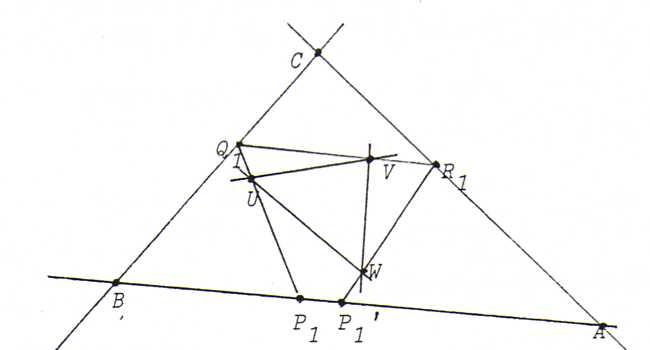COURSE OF PROJECTIVE GEOMETRY
§ 27:
O102
Fragment from Kaper-Westerman:
Note 3.5.1:
This yield the possibility to 'construct' the fixed points of a projective mapping φ from a line l onto itself.
Suppose a conic J has been drawn. Let φ be given by three points A, B, C and their images A', B', C' on l.
Take a point S on J and let A, B, C, A', B', C' be the projections of
A, B, C, A', B', C' on J from S.
Let ψ be the projectivity from J onto itself determined by A, B, C and their image points A', B', C'.
If the axis of J intersects J, then the projections of the intersection points from S on l are the fixed points of φ.
Fragment from "An introduction to Projective Geometry" by Daniel Pedoe:
3. The method of false positions.
If we have only three pairs of corresponding points on a line, the projectivity from the pencil of points on this line onto itself whereof these pairs are pairs of point and image point
is uniquely determined and can have 0, 1 or 2 fixed points.
There is a class of problems, first introduced by Poncelet, whose solutions depend on the existence and the construction of such fixed points.
The following is a typical example:
To construct a quadrilateral so that the four sides go through four given points and the four vertices go through four given lines.
Let A, B, C, D be the given points and l1, l2, l3, l4 the four given lines.
Draw any line through A, intersecting l1 and l2 in P1 and P2.
Draw BP2, which intersects l3 in P3.
Draw CP3, which intersects l4 in P4.
Draw DP4, which intersects l1 in P'.
This procedure determines a projectivity φ from l1 onto itself with φ(P1) = P'.
Now if we find the fixed points (0, 1 or 2) of this projectivity φ, this gives us 0, 1 or 2 solutions of the problem.
Because the production of three pairs of corresponding points requires the construction of three quadrilaterals that aren't close-fitting and, hence, don't yield a solution of the problem, the method
is called 'the method of false positions'. Three constructions that are false because they don't solve the problem give the material we need to solve the problem.
O103 Begin with three points P1, P2, P3 on AB and find by projection from U on BC the points
Q1, Q2, Q3. Then, find by projection from V on AC the points
R1, R2, R3. Finally, find by projection from W on AB the points
P1 ', P2', P3'.

We can use the fixed points of the projectivity with φ(Pi)=Pi' as starting points P for a close-fitting trianglePQR.
HOME
